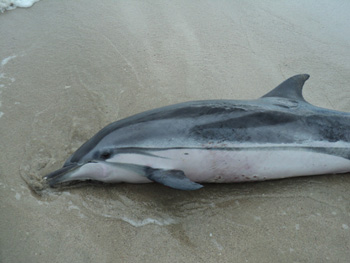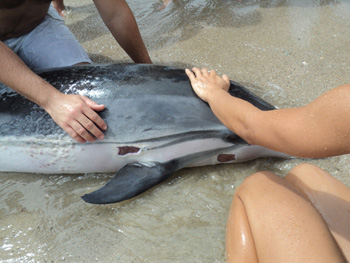Wednesday August 24, a third dolphin in 2 months was found beached and struggling in shallow waters on Guiones beach.
The porpous, a full grown, male, striped dolphin, had been spotted at 1 pm by beach goers. Several attempts were made to return the dolphin to deeper waters in hopes that it could regain orientation. Each time the dolphin returned to the shore.
Members of the Harmony Hotel staff and the tourist police began keeping an eye on the dolphin in the early afternoon and prevented members of the public from touching and crowding around the animal. Gerardo Bolanos, Harmony Hotel’s Sustainability Coordinator contacted MINAE, the federal Ministrerio del Ambiente y Energia (Ministry of Environment and Energy, Costa Rica) and was put in touch with a team of experts whose task it is to investigate incidences of beached dolphins.
Bolanos waited with the dolphin until it finally ceased its struggling and died at about midnight. “I was trying to keep it calm, and comfortable, it was difficult because there was nothing that I could do to help it,” said Bolanos. |
|
 |
| |
|
| |
 |
Veterinarian, Gabriella Hernandez, arrived on the scene just moments after the dolphin’s passing. Hernandez, working on behalf of the National University of Costa Rica, Medical Veterinarian’s Foundation and the Industry of Agriculture rushed to Nosara from Heredia when she received the call.
Hernandez, accompanied by a biologist from the National University collected the dolphin in order to do a full autopsy and test the animal to figure out why it beached itself and later died.
According to a study titled, Neurobrucellosis in Stranded Dolphins, Costa Rica, conducted by a team at the National University and spearheaded by Hernandez, ten stripe dolphins tested positive for neurological disorders. Each of the dolphins were found stranded in populated areas of the Pacific shoreline and each died within 48 hours of being found.
Without test results the reason for the dolphin’s behavior and death cannot be confirmed. However, Hernandez told VON that based on the dolphin’s behavior and physical attributes it is likely the dolphin has a similar condition to the ten dolphins referred to in the study.
The study describes the behavior of infected dolphins. Dolphins with the neurological disorder lose the ability to maintain buoyancy and often experience tremors and seizures.
Bolanos, who waited with the dolphin in the hours before its death, told VON that the animal was behaving strangely. “It was evident that something was seriously wrong, he was trembling, arching his body and it looked like he was disoriented and going through a lot of pain,” said Bolanos.
The test results will be available by the middle of September. In the meantime Hernandez believes it is important for people to know what to do when they see a stranded dolphin.
“It is best to try to return the animal to the water, but only once,” said Hernandez. “If a dolphin returns to the shore for a second time it will continue to do so, at this point it is best that we are contacted.”
The veterinarian told VON the best way to transport a dolphin back to the water is by lifting it with a towel. As little direct contact with the animal as possible is always best. Hernandez can be contacted through 9-1-1 or directly through the university.
| 
